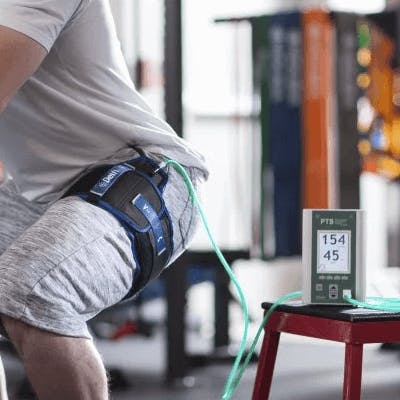
Blood Flow restriction training involves cutting off 50-80% of arterial circulation and 100% of venous circulation to an upper or lower limb. This is done in order to induce hypoxia in the muscles, which then stimulates metabolic activity leading to muscular hypertrophy.
A special tourniquet is used measure individualized blood pressures and precisely keep tourniquet pressure throughout the exercise session. Blood Flow restriction can be used on the arm or leg and the tourniquet is always placed at the top of the leg or arm.
Is Blood Flow Restriction Safe?
Yes. Our blood flow restriction tourniquet is FDA approved. You will wear the tourniquet for anywhere between five to fifteen minutes, which is enough time to induce a hypertrophy response, but will not cause limb damage.
How does Blood Flow Restriction work?
While wearing the tourniquet you will perform either a strength or endurance protocol. If performing the strength protocol you will perform four sets of the specified exercise. During the first set you will perform 30 reps, followed by 15 reps in sets two, three and four. If performing the endurance protocol you will bike, row or walk. You may do this at a steady pace or perform intervals.
While wearing the tourniquet it will be programmed to occlude 80% of arterial blood flow on the lower limb and only 50% of blood flow on the upper limb. All of the venous blood flow will be occluded. When exercises are performed with the tourniquet the body responds as if it had lifted at heavy loads, however you will only be working at an intensity of about 30% of your one rep maximum.
What Conditions Can Be Treated with Blood Flow Restriction?
Blood Flow Restriction can be used on almost any injury. Blood Flow restriction is safe to use post-operatively and can help preserve muscle mass when a patient has weight bearing restrictions. Blood Flow Restriction can also be used to effective treat tendonitis and overuse injuries. Blood Flow Restriction allows us to load the injured tissue without over stressing the injury
